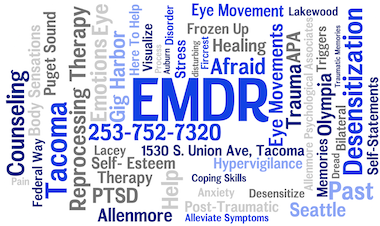EMDR Therapy – The Most Effective Approach For PTSD

Eye movement desensitisation and reprocessing (EMDR) can be used for the treatment of many psychological conditions. The method was developed in the 1980s by Dr Francine Shapiro, an psychologist from the USA, and has been found to help people suffering from PTSD by reducing the distressing symptoms they experience.

Following involvement in distressing events, people sometimes feel absolutely overwhelmed, and the memory of the distressing event may become frozen in their brain because it cannot be processed properly. This means that recalling the distressing memory can cause the person to experience the feelings again and see, hear, smell and even taste the things they experienced at the time. This can be very intense and distressing, and people may try to avoid recalling the distressing event, but sometimes they are reminded by something and experience flashbacks or distress which may cause them to experience feelings of guilt, irritability or isolation.
This relatively new treatment has been found to be effective in the reduction of PTSD symptoms, although the reason why it works is not understood. It involves the patient moving their eyes, usually by following the therapist’s finger as it moves from left to right, while they recall the traumatic event. It is thought that this causes alternate left and right stimulation of the brain and helps to free the frozen information processing system in the brain so that the flashbacks and distressing memories can be processed more effectively.
London EMDR therapy for PTSD can reduce the intensity of distressing memories so that they become more like ordinary memories and do not cause so much distress. During REM (Rapid Eye Movement) sleep, the eyes move from side to side, and EMDR therapy is thought to have a similar effect to this natural occurrence, allowing the negative emotional experiences to be released from the brain and nervous system.
The therapist will need to find out about your history and the kind of problems or distress you experienced before deciding that EMDR is right for you. Details of any physical problems and any medication you take will also be noted, and if you have any queries or concerns, you will be able to discuss these. Prior to the treatment the therapist will take you through some relaxation exercises.
A distressing memory can then be targeted using either eye movements or a different form of stimulation such as audio or tapping that alternates between left and right. You will be asked to think of an image representing the traumatic event and to think about your feelings, any negative or positive thoughts and how distressed you are feeling. Using London EMDR therapy for PTSD, the amount of distress is usually reduced as the memory is processed.
The therapy typically takes several sessions to reduce the amount of distress the memories produce, but reliving the memories can help by turning these negative experiences into more positive ones. This natural process works well for many people, particularly those suffering from Post-Traumatic Stress Disorder.
